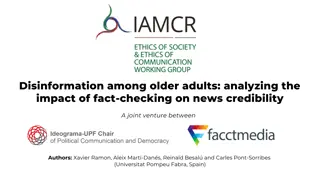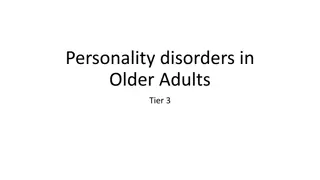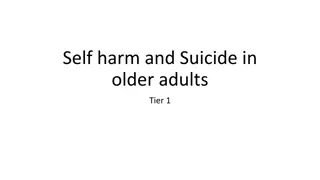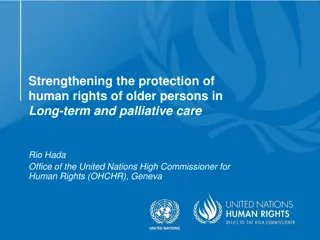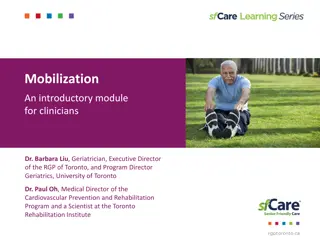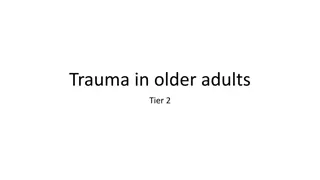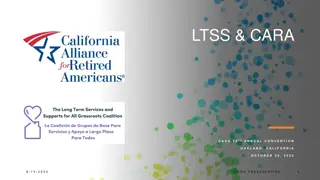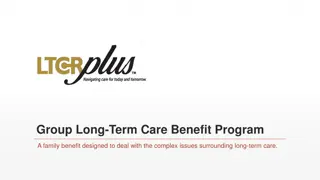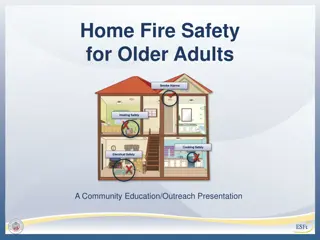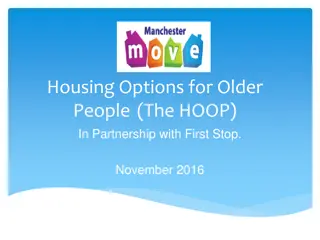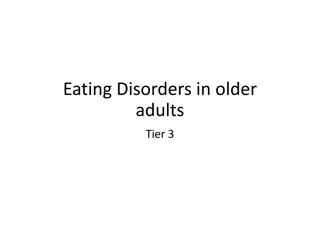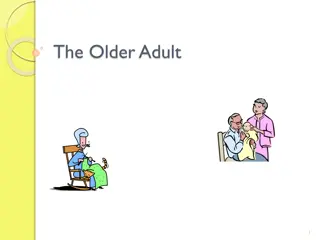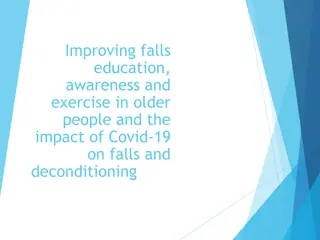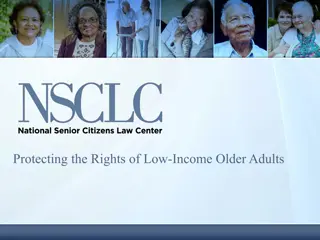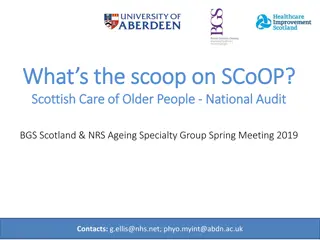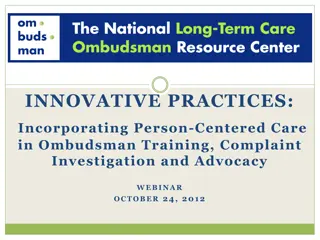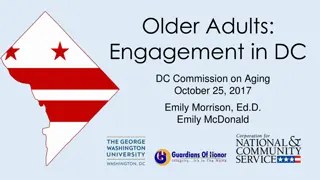Improving Long Term Care Services for older Adults
Orange County Department on Aging's initiative aims to enhance Long Term Care services for older adults, focusing on memory and movement at Chapel Hill Assisted Living Facility. Gabrielle Scronce presented on the correlation between dementia and physical activity, addressing barriers and suggesting activities for CH-ALF residents. The presentation included audience participation and feedback, emphasizing the importance of engaging staff in enhancing resident care.
Download Presentation

Please find below an Image/Link to download the presentation.
The content on the website is provided AS IS for your information and personal use only. It may not be sold, licensed, or shared on other websites without obtaining consent from the author.If you encounter any issues during the download, it is possible that the publisher has removed the file from their server.
You are allowed to download the files provided on this website for personal or commercial use, subject to the condition that they are used lawfully. All files are the property of their respective owners.
The content on the website is provided AS IS for your information and personal use only. It may not be sold, licensed, or shared on other websites without obtaining consent from the author.
E N D
Presentation Transcript
Memory and Movement Chapel Hill Assisted Living Facility Gabrielle Scronce March 18, 2014
Message to Reviewers from Gabrielle My actual presentation followed this power points as notes only; the actual slides were not presented. I used a flip chart to outline topics and pose questions to the audience. I added ideas from staff to the flip chart to encourage participation from the audience Handouts provided to the audience included Slides 3, 21, and 23 as well as Mobility in Action handouts from Cherie Rosemond. Gabrielle will use a flip chart to note ideas from staff and to demonstrate important points I presented to two sets of staff at CH-ALF. One presentation occurred from 10-11am to 7 CNAs and Med Techs, and the second was from 2-3pm to 12 staff members including CNAs, Med Techs, Special Care Manager, and Activities Coordinator. Staff from all shifts attended the meeting, though not all staff from the Memory Care Unit were able to attend. To share feedback from the staff audience that occurred during the presentation, I have added slides and notes in blue font to indicate staff responses.
Movement and Memory Presentation Outline Initial survey Introductions Even Better Dementia = memory loss + __________ Physical activity = activity that increases heart rate and requires the use of large muscles Physical activity for people with dementia Activities for CH-ALF Barriers to physical activity Final survey Thank you
Distribute survey Offer snacks to participants Distribute pre-presentation survey, pens, notepads upon people s arrival
Introductions My name is Gabrielle Scronce 3rdyear PT student at UNC Go around the room, have everyone state their name, what they do at CH-ALF, and who or what led them to working with older adults I am here for 2 reasons: Capstone project I met Special Care Manager at a presentation in June, and she asked me to help with CH-ALF with Even Better
Introductions Many staff members shared personal and meaningful stories describing influential older adults in their lives and how these relationships connected them to the work they do today. Some staff members shared what they like about their work at CH- ALF, including making residents smile, hearing residents stories, and knowing that they re making a difference for people who have no family.
Even Better Orange County Department on Aging initiative to improve Long Term Care services Three parts to Even Better Start or expand a program Increase physical activity in the memory care unity Demonstrate positive outcomes Counting the number of programs offered, number of residents who participate Show administrative support for sustainability Final reports due April 30 Chance for $200 prize, recognition and media exposure for CH-ALF
Even Better Staff members besides Special Care Director and Activities Coordinator were unaware of CH-ALF s involvement in the Even Better program. Staff members in the morning session (no management present) expressed concern that the facility director would keep the award money and media attention for herself.
What is dementia? (Question posed to staff with additional explanation of What do you see in your residents? and What comes to mind when you think of dementia?) Morning Group Brain Memory Confusion Behavior Listening Thoughts Speech Judgment Afternoon Group Confusion Skill loss Decreased alertness Disoriented Agitation Aggressive Ask the same questions over and over: Where are we? When am I moving? Where is the bathroom? Memory loss
What is dementia? (Smith, 2009) Dementia is memory loss + Loss of speech Inability to perform regular tasks Inability to recognize people and objects Inability to plan activities
What is physical activity? (Question posed to staff with explanation, What do you think of when you hear physical activity ? ) Morning Group Torture Exercise In shape Bones Strength Muscles Heart rate goes up Movement Flexibility Afternoon Group Movement Getting up in the morning ADL s Childcare Games (for residents) Interaction (for residents) Any activities (for residents)
What Is Physical Activity? Aerobic exercise includes activities that require the use of large muscle groups in the body. (Yu, 2009) The National Institute on Aging recommends that older adults participate in at least 30 minutes of moderate aerobic exercise every day. (Yu, 2009) Increase in heart rate for 20-30 minutes (Ahlskog, 2011)
YOUR ideas for physical activity at CH-ALF: Morning Group Walking Parachute (not sure if they still have it) Balloon toss Bowling Exercises Afternoon Group Music Dancing Clapping Marching Stomping Walking Balloon toss Seated exercises
What are the options for physical activity for residents in the Memory Care Unit at CH-ALF? Think outside the box: what activities increase heart rate and require muscles to work for our residents? Walking Balloon toss Sit<>stand Ask residents to perform 5 sit<>stands to illustrate how this is an exercise that can quickly elevate heart rate Discuss how important sit<>stand ability is for older adults and how I ask my grandmother to do these when I call her on the phone and another person is in the house with her for safety. CNA asked for example of exercise that wasn t as difficult as 5 sit<>stands. Suggested 1 sit<>stand, sit<>stand from elevated chair, isometric gluteus contractions in sitting. Activities of daily living (Kolanowski, 2006) Dancing Residents with severe dementia are less able to participate in regular aerobic exercise, so we have to be creative to find ways to encourage them to move.
Why bother to increase physical activity for people with dementia? Morning Group We care Blood flow Can increase awareness Keeps residents busy, occupied Improves behavior Helps residents sleep Afternoon Group Get residents motivated Keep residents active: if you don t use it, you lose it Helps residents remember things
Why Increase Physical Activity for People with Dementia? Physical activity can be used in place of medications (Kolanowski, 2010) NOTE: I did not discuss this in presentations. Over time, medications can speed up the process of decline Non-medication treatments should be used first. Physical activity can increase awareness and alertness (Ahlskog, 2011; Yu, 2009) Exercise makes your brain work better; it increases blood flow to your brain, and not just while you re exercising. Exercise helps lower your risk for developing dementia if you don t have it. Regular aerobic exercise can slow the progression of Alzheimer s disease and improve thinking Physical activity can improve behavior (Yu, 2009; Gitlin, 2009; Smith, 2009) Aerobic exercise can reduce depression, frustration, and sleep disorders Participating in activities can calm people who are agitated or aggressive Participating in activities can energize people who are passive Participation in activities can reduce depression, increase appetite, and increase quality of sleep (Smith, 2009; Kolanowski, 2006) Participation in activities can reduce need for oversight and time spent caregiving by care providers. (Gitlin, 2009) If you don t use it, you lose it. When people are not active and they are not engaged in their surroundings, they lose physical abilities, feel lonely, and are more likely to have behavioral issues. (Kolanowski, 2006)
Who can help? Who is responsible? Morning Group Everybody Afternoon Group All of us
Who can help? Everyone. When all members of the staff are involved in promoting activity and wellness, residents quality of life and levels of depression improve. (Buettner, 2010) Physical and occupational therapy, nursing, social work, activities, and family members should communicate about activity levels and functioning of residents. Each person has a different background with different skillsets that can help the resident. When volunteers are in the unit, that is a wonderful time for staff to connect with residents and to encourage participation.
Gabrielles General Recommendations for Activities at CH-ALF: Activities should occur throughout the day Activity coordinator has limited time divided among different people. Staff in the memory unit are with residents all day and can provide activities for residents. Activities should be suited to the resident s interest and abilities How do you know what each resident s interests are? Talking with the resident Talking with other staff Morning Suggestion: Another ALF where I worked had a piece of paper posted in each resident s room that had a list of things that the resident liked and disliked including what the person used to do for a living. I could just look at the paper on the wall and say, Tell me about _____, and the resident would be ready to talk about it or more willing to do what I was asking them to do. Morning Comment (from med tech): I don t spend much time in the rooms, so I think it would be better to have that at the nurse s station. Morning Comment (from CNA): I think we should have something in each room and at the nurse s station. Afternoon Suggestion: Another ALF where I worked had a notebook that we kept at the nurse s station. The notebook had a page for each resident that had things that the resident used to do or liked. I think we need something like that here.
Gabrielles General Recommendations for Activities at CH-ALF (continued): Activities that are suited to a resident s current behavior Try calming activities for agitated residents and energizing activities for sedated residents. Choose activities that promote success Small group or one-on-one activities work best for people with dementia. Group activities may be too difficult, over-stimulating, or uninteresting for individuals. (Smith, 2009)
Activity Suggestions for CH-ALFs Memory Care Unit Memory Tea Guided Imagery (demo) Aromatherapy Nice smelling lotion Walking Indoor, Outdoor Cooking Mixing ingredients Placing dough on trays Preparing finger foods Setting and decorating the table Cutting coupons out of the paper Arranging flowers in a vase Corn hole Matching cards Massage Sensory box (demo) Price is Right game (demo) Move to the Music Dancing Exercises Balloon toss Clubs to address interests Birds, jewelry, dolls, dogs, cars Sorting photographs Singing Folding laundry Caring for baby doll Snapping green beans Dusting the furniture Winding yarn Active and Passive Range of Motion (demo) Mobility in Action (demo, provide handouts) Encourage conversation
Activity Suggestions for CH-ALFs Memory Care Unit (Gabrielle s explanations of certain activities) Memory Tea You can offer tea or coffee and just talk with residents Sometimes we have coffee for the residents, and they really love it. Guided Imagery I offered a demonstration, asking staff to close their eyes, imagine that they were on the beach, etc. Staff enjoyed this! Walking Indoor, Outdoor We used to take residents outside for walks more often. Is there a reason why you stopped? Not sure why we stopped, but we can try again now that weather is nicer. Massage Massaging a resident s hands with lotion or just rubbing a resident s back can be soothing. Sensory box I passed around the sensory box I made for CH-ALF Price is Right game I asked staff to guess whether the chapstick or shampoo was more expensive. I turned over the items to show in large print what their costs were. Discussed ways to expand this activity for residents Have them Come on Down! Discuss prices Active and Passive Range of Motion Staff were familiar with these concepts. We had an interactive discussion thinking of residents who needed passive range of motion. Mobility in Action Discussed each Mobility in Action Card briefly Provided Mobility in Action cards for all staff
Activity Recommendations for Different Levels of Dementia (Buettner 1999; Buettner 2003) Name of high functioning resident Name of resident with speech and upper extremity strength but needs to use a wheelchair because of lower extremity weakness Name of resident dependent for all needs. Standing dance, yoga, games, marching Seated exercise to music; sit to stand exercises with staff supervision Passive range of motion: observe her face for signs of discomfort Sports Seated sports Massage Walking group Self-propel wheelchair group Push in wheelchair Kitchen activities Seated food preparation activities Active-assisted eating Preparation for special events: decorating, food preparation, pushing wheelchairs, greeting, assisting Preparation for special events: supervising decorations, finger food preparation Participation in special events: Able to see/hear/feel/touch/taste Standing balloon toss game Seated balloon toss game Reach for balloon (one-on-one) Birdwatching club Jewelry club Dog club
Activity Recommendations for Different Levels of Dementia - Discussion Interactive discussion of activities Named a few residents who fit into each of the three categories from the previous page
Fit the activity for the behavior (Kolanowski, 2008; Buettner, 2006) Residents who are passive and inactive are at risk for feelings of isolation, further cognitive decline, and faster loss of function. The best activity depends on the resident. Energizing to increase activity = small to medium sized groups Walking Wheelchair pushing Balloon toss Walk outdoors Calm to increase comfort = individual or very small groups Sensory box Massage Wave bottle Feelings box Talk about your feelings Timing is also important offer the activity when the resident needs it.
Fit the activity for the behavior - Discussion Main points from the previous slide were written on a flip chart for staff to read as I explained the concept of fitting and timing activities based on individual behaviors. Staff discussed (mostly among themselves) certain residents who frequently present aggressive behavior. Staff said that with some residents, it s best to just stay out of their way when they are aggressive. Demonstrated the feelings box adapted from Kolanowski 2008 Empty Celestial Seasonings tea box wrapped in white paper with the 4 long sides each having one word written on it: happy, sad, mad, calm Toss the box and ask the resident to share what it s like to have the feeling written on the box. CNA: I think this would work well for specific resident who has a hard time telling us what s wrong when he gets upset.
Think of residents with early or mild dementia Involving these residents in activities can help them to better manage their condition (Buettner, 2009)
Think of ways to include residents who are normally left out (Kolanowski, 2006) Residents are more likely to be excluded from programs when they display agitation or apathy or when they are new Asked staff to remember residents with severe dementia who are unable to participate in voluntary activities and can only smile or squeeze hands in response Staff discussed 2 residents who respond only to one-on-one interactions.
Barriers to activity at CH-ALF: (Question for staff to answer) Staff are unprepared to handle aggressive, agitated residents. Not enough money for things like hand-held massagers, fitness equipment, other materials. Administrators recently bought 2 flat screen tv s even though what we really needed was a stationary bike or other materials for activities. Activities Coordinator has not been in the Memory Care Unit for over a week because she has other responsibilities. Norma (Activities Coordinator in June) used to come to the Unit every day for bingo and then another time every day for another activity. The residents in the Unit love bingo, and the staff always helped. Now it s like we don t even have an Activities Coordinator except when you re (Gabrielle) here My response: I have been dedicated to CH-ALF because I have seen that there is a need for increased activities and because I saw that the staff here really care about the residents. I appreciate all the help that you have given me, and I know that you can continue to apply that energy to increasing activities with residents. Remember the Mobility in Action cards and how you can turn ADLs into activities. You have offered many great ideas today that you can use with the residents even without help from an Activities Coordinator. After I am no longer able to come, you will have more volunteers coming in who can continue to help you with activities. I later shared the interest in bingo with AC, and she has since offered the activity several times with assistance from CNAs in the Memory Care Unit. Time: Some of our residents require so much time that we can t do for them all they need, and we still don t have time to do activities. Remember that every small thing that the residents can do for themselves is a step in the right direction. For residents who can do things on their own, encourage that. Ask for help with things like setting the tables, putting away laundry, and other simple tasks. This can help save you time. (Kolanowski, 2010; Kolanowski 2008)
Thank you Final survey Certificate of completion Hand sanitizer/lotion gift
References 1. AhlskogJE, Geda YE, Graff-Radford NR, Petersen RC. Physical exercise as a preventive or disease-modifying treatment of dementia and brain aging. Mayo Clin Proc. 2011;86(9):876 84. doi:10.4065/mcp.2011.0252. 2. Buettner LL. Simple Pleasures: A multilevel sensorimotor intervention for nursing home residents with dementia. Am J Alzheimers Dis Other Demen. 1999;14(1):41 52. doi:10.1177/153331759901400103. 3. Buettner LL. Importance of interdisciplinary perspective in recognizing and treating depression. Res Gerontol Nurs. 2010;3(3):146 7. doi:10.3928/19404921-20100601-03. 4. Buettner L, Fitzsimmons S. Mixed behaviors in dementia: The need for a paradigm shift. J Gerontol Nurs. 2006:15 23. Available at: http://libres.uncg.edu/ir/uncg/f/L_Buettner_Mixed_2006.pdf?origin=publication_detail. Accessed March 16, 2014. 5. Buettner L, Fitzsimmons S. Promoting Health in Early-Stage Dementia Evaluation of a 12-Week Course. J Gerontol Nurs. 2009;35(3):39 49. Available at: http://libres.uncg.edu/ir/uncg/f/L_Buettner_Promoting_2009.pdf. Accessed March 16, 2014. 6. Buettner L, KolanowskiA. Practice guidelines for recreation therapy in the care of people with dementia. Geriatr Nurs. 2003;24(1):18 23; quiz 24 5. Available at: http://www.ncbi.nlm.nih.gov/pubmed/12598862. 7. Gitlin LN, Winter L, Vause Earland T, et al. The Tailored Activity Program to reduce behavioral symptoms in individuals with dementia: feasibility, acceptability,and replication potential. Gerontologist. 2009;49(3):428 39. doi:10.1093/geront/gnp087. 8. KolanowskiA, Buettner L, Litaker M, Yu F. Factors that relate to activity engagement in nursing home residents. Am J Alzheimers Dis Other Demen. 2006;21(1):15 22. doi:10.1177/153331750602100109. 9. KolanowskiA, Buettner L. Prescribing activities that engage passive residents. An innovative method. J Gerontol Nurs. 2008;34(1):13 18. Available at: http://www.ncbi.nlm.nih.gov/pmc/articles/PMC2736598/. Accessed March 16, 2014. 10. KolanowskiA, Fick D, Frazer C, PenrodJ. It s about time: use of nonpharmacologicalinterventions in the nursing home. J Nurs Scholarsh. 2010;42(2):214 22. doi:10.1111/j.1547-5069.2010.01338.x. 11. Smith M, KolanowskiA. Beyond bingo: meaningful activities for persons with dementia in nursing homes. Ann Long- . 2009;17(7):22 30. Available at: http://www.annalsoflongtermcare.com/content/beyond-bingo-meaningful-activities-persons-with-dementia-nursing-homes?page=0,4. Accessed March 15, 2014. 12. Yu F, KolanowskiA. Facilitating aerobic exercise training in older adults with Alzheimer s disease. Geriatr Nurs. 2009;30(4):250 9. doi:10.1016/j.gerinurse.2008.11.001.


